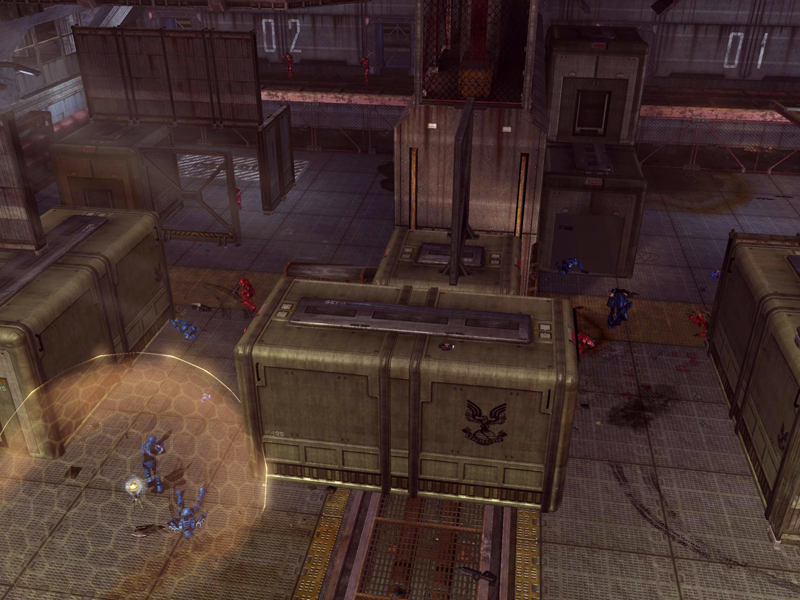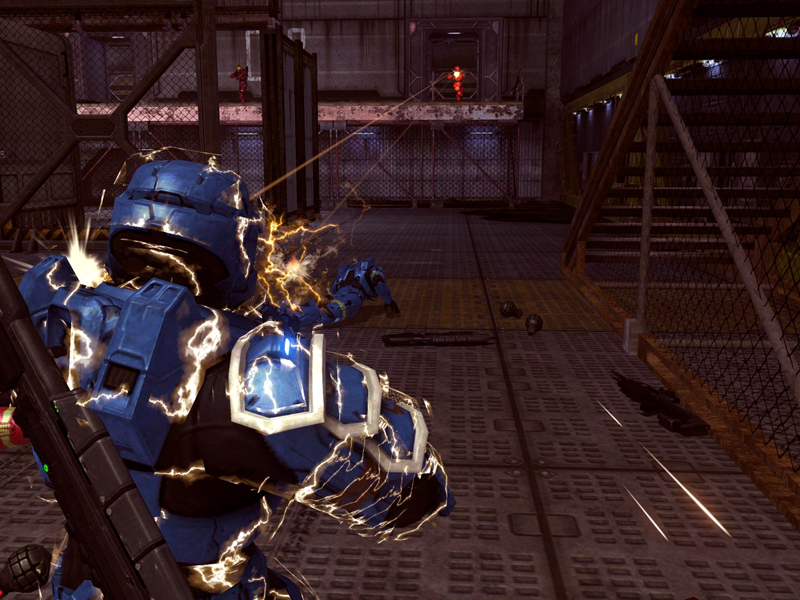broad-minded player with no strong preferences for any multiplayer maps on Halo 3, Michael faced a manifest challenge in completing his review of Halo 3's first edition of downloadable content, the Heroic Map Pack. Donning a white lab coat, safety goggles and headset, he loosely applied the scientific method; securing objectivity through rigorous use of relatively uncomplicated sentences, clinical language and the passive voice. The results of his study follow.
Standoff

Fig. 1

Fig. 2

Fig. 3Summary: Two bunkers, with accessories, dug into gently rolling hills.
Observations: Simpler, illustrative interior surface, more reminiscent of Halo: Combat Evolved's comic-book styling than Halo 2, or even the eleven original maps for Halo 3. The red team's base and blue team's base are each clearly distinguished from inside, the former an intense red. Outside, the landscape feels vast, though its total area may not be larger than Valhalla; let alone Sandtrap. Several distinct parts of the map, from boulders to hills to launch pads, are likely conducive to multiple tactical experiences (see Fig. 1). Peculiar open tracts, apparently wasted space, at a few edges of the area. When struck with weapons fire, forklifts on the map explode.
Hypothesis: A map that seems like a cross between Valhalla and Halo 2's Sanctuary will carry some play value.
Matchmaking Experiment: Twelve players fit impeccably. Warthogs, generally depreciated to moving targets in Halo 3, had just enough room to effectively zig-zag across the map (see Fig. 2). The variety of terrain prevents an overuse of power weapons and vehicles, boulders interposed between the bunkers especially useful for furtive advances on foot. Groups of two or three players frequently snuck across the map's rocky middle with an ease seldom seen in Halo 3's multiplayer to date. A fast-moving game of VIP resulted in the red team pushing so hard as to displace the blue team — whose team members spawned, for a few minutes, in or around the red base (see Fig. 3).
Preliminary Conclusion: Standoff works as designed; predicted to be a favorite.
Foundry

Fig. 3

Fig. 4

Fig. 5Summary: Hangar-sized warehouse filled with industrial equipment. And cargo. And armed Spartans.
Observations: From starting position, the map looks like a dark corner of The Pit. Lighting and colors moodier; indigos and deep auburns. Spacious, as partitions and crates define areas that are cozy, rather than cramped. Ribbed baffles and stacked gondolas serve as makeshift walls and tunnels. One warehouse wall is, with its gigantic fans, a timely reminder of the rooftop chase in the movie Blade Runner (see Fig. 4). Moving back towards the middle, a glance upwards reveals the ceiling as a maze of ductwork, culminating in square-paned skylights. Design of the map evidently focused on realistic boundaries: instead of sentry guns or mines at an arbitrary perimeter, doors and gates mark an operative edge, while corridors beyond lead to somewhere out of sight. Forklifts explode.
Hypothesis: Elaborate and appealing, but design will not bear out in practice.
Matchmaking Experiment: Meant for Forge and custom games or not, Foundry's original configuration turned twelve players into a purposeless, grenade-buffeted jumble. Most of the map was overlooked as both teams swarmed to the warehouse's center (see Fig. 5). Attempting "run-and-gun" tactics, supported by neither luck nor exceptional skill, ended in low scores. Conversely, holding a position on the raised platform outside a base was highly successful, especially using a battle rifle or sniper rifle — players, already engaged and/or damaged, would stray into line-of-sight (see Fig. 6). Since the bases are practically adjacent, a game of Capture-the-Flag or Assault would almost certainly involve only half of the map.
Preliminary Conclusion: Best reserved, in a Forge-constructed variation, for small teams with small arms.
Rat's Nest

Fig. 3

Fig. 4

Fig. 5Summary: A pair of garages — separated by a wide lane, girdled by a tunnel.
Observations: Low ceilings at spawn point. Rectilinear tunnels are immediately outside, possibly too wide for provided obstacles and cover — Elongation and its frustrating shortcomings come to mind (see Fig. 7). Vehicles are plentiful. True to its namesake, the map expands as the first tour progresses. A Pelican dropship — on an isolated, pillar-like pad — is a tease. Most players would react by heading straight for the vehicle and climbing all over it, but the Pelican is inaccessible. Rat's Nest, as per Bungie's intent, appears as an extension of Halo 3's single-player level "Crow's Nest," but also a slightly tidier industrial dilapidation of Half-Life 2's City 17. No forklifts.
Hypothesis: The map looks big but feels small, and will be overwhelmed by two full teams.
Matchmaking Experiment: Twists and turns did not actually deprive players of space (see Fig. 8); instead, they easily disoriented. A lack of direct routes from one base to the other separated players from urgent situations, such as a planted bomb or stolen flag — a similar limitation on Narrows that was countervailed by man-cannons. In Slayer games, the front-facing T-intersection was the site of several intense rifle exchanges, its collection of concrete barriers the most interesting set of obstacles on the map (see Fig. 9). Rat's Nest suffered the greatest network lag of the three maps; it also received a conspicuously high number of players' vetoes just a few days after launch.
Preliminary Conclusion: Not small, after all — labyrinthine and idiosyncratic. Will likely polarize players.



































